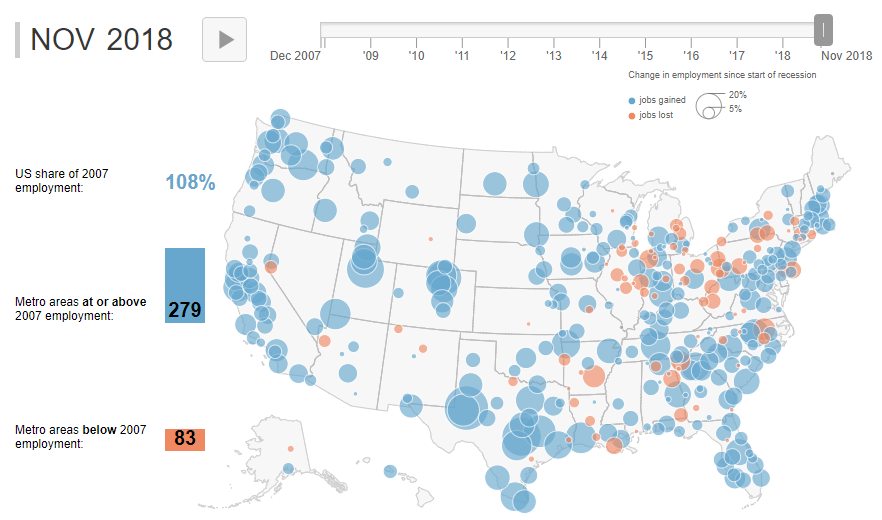TIP Strategies continues to track patterns of regional employment disparity in the US economy with our Geography of Recovery interactive map.
As of November 2018, seasonally adjusted nonfarm employment in the US approached 150 million for the first time. November’s figure represents a gain of more than 11 million jobs from December 2007, the month officially recognized as the start of the Great Recession. That’s the good news. The US not only gained back all the jobs it lost during the recession, but it has also added an extra 11 million from the previous peak.
The strong gains mask some bad news, however. As with any national economic cycle, the ups and downs are spread unevenly across the country. Out of the 362 US metropolitan areas TIP Strategies monitors, the recession still lingered in 83 of them as of November 2018. In other words, despite nearly a decade since the recession’s official end, these metropolitan areas still have fewer nonfarm jobs than they had at its start. These metro areas with lagging job growth are predominantly located in the eastern half of the country and tend to be less populated. In some cases, the job deficits are significant. Rocky Mount, North Carolina, and Pine Bluff, Arkansas, both had employment levels in November 2018 that were 17 percent below where they were when the Great Recession began.
Conversely, net job changes in the nation’s larger metros clocked in mostly in positive territory as of November 2018. Even metropolitan Detroit, where the central city experienced a painful bankruptcy in 2013, was 3 percent above its December 2007 employment level. Metro areas that we think of as “college towns” bounced back strongly, too. Examples include Provo, Utah, where jobs were up 41 percent; Fort Collins, Colorado (up 28%); Morgantown, West Virginia (up 21%); Ithaca, New York (up 16%); Ames, Iowa (up 15%); and Ann Arbor, Michigan (up 11%).
At TIP Strategies, we spend a lot of time thinking about what uneven economic growth means for inequality. Our work exposes us to both ends of the spectrum, from affluent suburbs straining to cope with the pace of growth to small metropolitan areas hoping to retain their young adults. We understand these challenges and recognize that success begins with creative economic strategies that fit the unique needs of each client.



